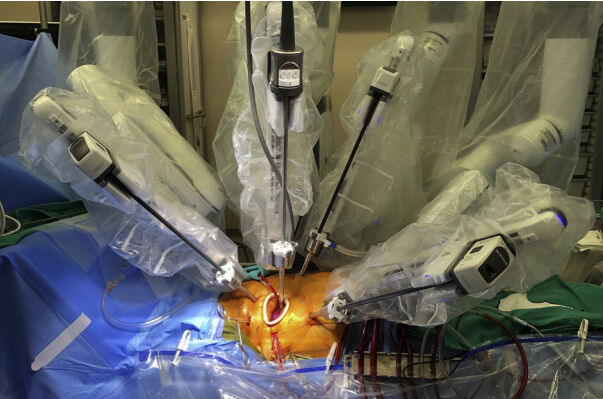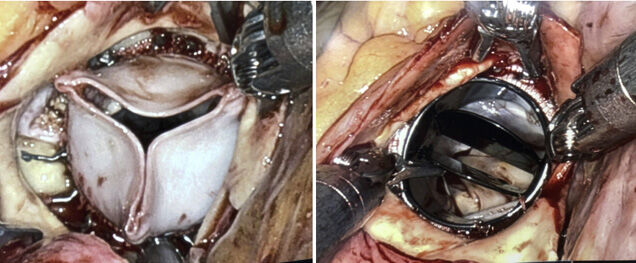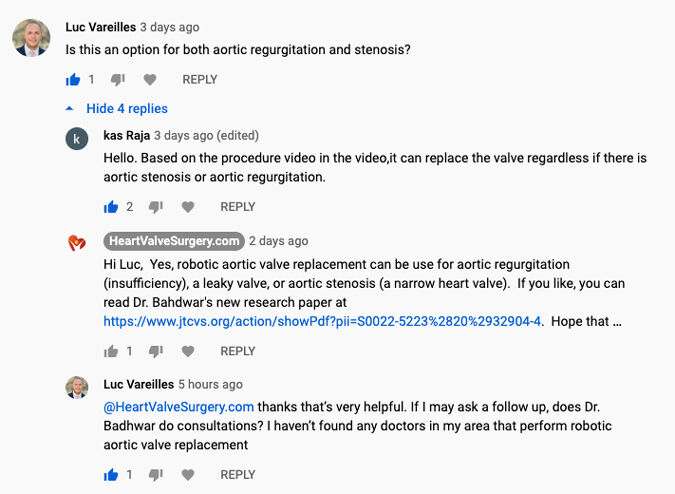Medical Technology: Is Robotic Aortic Valve Replacement the Newest Innovation in Cardiac Surgery?
Written By: Adam Pick, Patient Advocate, Author & Website Founder
Medical Experts: Vinay Badhwar, MD, Executive Chair of WVU Heart & Vascular Institute
Page last updated: February 12, 2021
While robots have helped cardiac surgeons perform mitral valve repair surgery for over 20 years, the use of robotic technologies for aortic valve replacement surgery has been minimal.
According to Dr. Vinay Badhwar, the Executive Chair of WVU Heart & Vascular Institute in Morgantown, West Virginia, that is about to change. In his new research paper, “Robotic Aortic Valve Replacement”, Dr. Badhwar reveals favorable results from the completion of 50 aortic valve replacement operations using a robot.
To learn more about this exciting development in cardiac surgery, we interviewed Dr. Badhwar about his new research and the future of robotic aortic valve replacement. Here are the highlights from our discussion with Dr. Badhwar, who has performed successful surgery on many patients within the HeartValveSurgery.com community.
Given the success and enthusiasm of Dr. Badhwar specific to robotic aortic valve replacement, it appears that “rAVR” (robotic aortic valve replacement) may be the newest acronym for patients to learn among SAVR, TAVR, MVR, MVr, TMVR and TMVr.
Key Learnings About Robotic Aortic Valve Replacement (rAVR)
In this video interview, Dr. Badhwar shared several great points that I wanted to jot down for all the patients in our community to learn from:
- Dr. Badhwar has performed over 5,000 cardiac procedures and more than 3,000 heart valve repair and/or replacement operations.
- Dr. Badhwar became a cardiac surgeon and specializes in heart valve therapy because this work provides Dr. Badhwar a unique opportunity to help people who are suffering from heart disease through the use of minimally-invasive techniques. Dr. Badhwar describes the opportunity to restore quality-of-life for his patients as “magical”.
- The development of Dr. Badhwar’s approach to robotic aortic valve replacement has taken years to develop and required extensive lab work.
 Robotic Aortic Valve Surgery Platform
Robotic Aortic Valve Surgery Platform
- During rAVR, there is no incision to the patient’s sternum or ribs so recovery is much faster.
- For his new research paper, Dr. Badhwar and his team completed 50 robotic aortic valve replacements. The patient outcomes for rAVR have been excellent. The procedures have been safe and effective. On average, the patient is in the hospital for three days after rAVR. Follow-up ultrasounds show the heart and heart valves to be functioning without issue and patient symptoms have returned to baseline.
- According to Dr. Badhwar, robotic aortic valve replacement provides low-risk patients a minimally-invasive alternative to transcatheter aortic valve replacement.
 Robot-Implanted Tissue Valve (left) & Mechanical Valve (right)
Robot-Implanted Tissue Valve (left) & Mechanical Valve (right)
- Specific to valve replacement type, Dr. Badhwar has implanted both mechanical and tissue heart valve replacements during rAVR.
- Dr. Badhwar believes the future of robotic aortic valve replacement is bright. His team has recently began using the robot for aortic valve replacement patients who also require concomitant procedures for multiple valve operations and simultaneous atrial fibrillation therapies.
Are Patients Interested in Robotic Aortic Valve Surgery?
It’s amazing to see that patient interest for robotic aortic valve replacement is already starting to grow.
Upon posting Dr. Badhwar’s interview at the HeartValveSurgery.com YouTube Channel, we saw an interesting exchange among Luc and Kas about robotic aortic valve surgery. Luc, who has been diagnosed with aortic valve disease, is interested in setting up a consult with Dr. Badhwar.

Thanks to Dr. Badhwar & WVU Heart & Vascular Institute
On behalf of our patient community, we would like to extend a tremendous thank you to Dr. Badhwar for taking the time to share this exciting new research with our community. We would also like to thank the entire team at WVU Heart & Vascular Institute (Dr. Wei, Dr. Roberts, Tony, Benjamin, Frank, Daniella, Ashley) for their patient care and their help setting up this interview.
Related articles:
- Download “Robotic Aortic Valve Replacement” by Dr. Vinay Badhwar
- See Dr. Badhwar’s Interactive Surgeon Profile
- Explore the WVU Heart & Vascular Institute’s Heart Valve Microsite
Keep on tickin!
Adam
P.S. For the hearing impaired members of our community, we have provided a written transcript of our interview with Dr. Badhwar below.
Video Transcript:
Adam: Hi, everybody, it’s Adam with heartvalvesurgery.com. Today, we have a very special surgeon Q & A all about the innovation of robotic aortic valve replacement surgery. I am thrilled to be joined by Dr. Vinay Badhwar, who is the Executive Chair at WVU Heart & Vascular Institute in Morgantown, West Virginia. During his extraordinary career, Dr. Badhwar has performed over 5,000 cardiac procedures with more than 3,000 involving some for of heart valve replacement or heart valve repair. Dr. Badhwar, thanks for being with us today. It’s great to have you hear.
Dr. Badhwar: Great to see you, Adam. I’m glad to be here.
Adam: We’re going to talk all about the innovation of robotic aortic valve surgery, but first can we maybe start with a question about you? When and why did you want to become a cardiac surgeon?
Dr. Badhwar: Back in early days in training and medical school, it’s just something I gravitated to because everybody wants to help people. That’s the usual answer. To be able to help people by restoring life to normal through something that you can do, it’s a magical thing that makes me happy every day coming to work.
Adam: Dr. Badhwar, by you going to work, you’re helping save the lives of a lot of patients out there, so thank you so much. Let’s talk about valve therapy, which is one of your specialties. What is it about valve repairs and valve replacements that’s so attractive to you?
Dr. Badhwar: The ability to change someone’s quality of life, valvular disease, as you know from all of your followers and patients, since you know all to well, they suffer a lot. By correcting blood flow, and doing so through surgical therapy, in this case ultra-minimally invasively, people can recover very rapidly. Their quality of life can come back to essentially near normal.
Adam: Dr. Badhwar, let’s get on to this incredible research paper that I just read. Can you share with all the patients who are all over the world, what was it that you studied in this new paper?
Dr. Badhwar: Adam, this paper is really the culmination of several years of work. Instead of doing valve surgery, particularly aortic valve surgery, through either a minimally invasive incision in the front, or regular sternotomy, or even a thoracotomy in their right top of the chest, we’ve actually done this now all robotically through the exact same method we use for our hundreds and now thousands of robotic mitral valve operations through a tiny little incision, through the ribs on the far side of the right side without touching the ribs or any muscles. Recovery is far quicker.
Adam: Dr. Badhwar, to help me and the patients, can you shine some light on some of the steps needed to do a robotic aortic valve replacement?
Dr. Badhwar: In the robotic aortic valve operation, we put our patients on cardiopulmonary bypass through tiny little incisions in the neck and in the groin. Then I put the heart to sleep in a conventional way, open the aorta, take out the old valve. This is an important difference. In TAVR, the existing valve stays in place.
In this case, we do the exact operation that we do in an open operation taking out the valve, cleaning out the annulus, or the ring of the valve, and then sew in, individually, placing specific stitches on a direct vision, and insert the valve in a conventional way, and close the aorta, and let the heart restart. This is all done using robotic assistance.
Adam: Is there some fundamental differences between the approach for aortic robotic surgery and mitral robotic surgery?
Dr. Badhwar: Yes, Adam, it is the exact same platform that we’re using. That’s the innovation. Previously, most surgeons approached that either through direct vision, a slightly larger incision, more through the big muscle groups, whereas this does not. As a result, this allows for quicker recovery, better access. This is really the innovation that we’re talking about. The paper is just one highlight of how the whole thing was developed.
Adam: Dr. Badhwar, can you share what that highlight is and some of the details of this research?
Dr. Badhwar: The pathway, really, is to develop how to do it. That’s what that paper does. Now, at WVU Heart & Vascular Institute, it’s now become a routine operation. In fact, throughout our unfortunate pandemic, this is one thing we have been doing with great regularity. We’ve now done over 50 pages since we started this at the beginning of the pandemic because aortic stenosis and severe aortic valve disease must be treated. This was a priority. As such, our experience has grown quite exponentially in helping lots of patients.
Adam: Dr. Badhwar, I love hearing about the experience you’re taking from the mitral valve usage of a robot and applying it to the aortic valve. I’m guessing a lot of the patients are wondering out there, what were some of the outcomes of these 50 robotic aortic valve replacement procedures you and your team performed?
Dr. Badhwar: We wanted to make sure we do this safely, efficiently. This was built upon a lot of lab type of work. From a patient perspective, everyone has done extremely well. Everyone has recovered completely. The length of stay in the hospital has been on average about three days. All of our follow-up, ultrasounds, and their clinical examinations essentially show that their heart functions, and their valves, and most importantly, their symptoms, have returned to a normal baseline.
Adam: Dr. Badhwar, I’m sure patients are wondering, robotic mitral valve surgery has been around for a long time. Why are you now just investigating the use of the robot for aortic valve replacement.
Dr. Badhwar: Patients are really looking for less invasive, minimally invasive techniques as the advent of the transcatheter aortic valve replacement, which all of your patients and viewers know all too well. When patients are of lower risk, or a younger age, or they have bicuspid valve disease, these are situations where maybe the TAVR valve is not necessarily the best for long-term outcomes.
We built this platform on something we know very well. Aortic Valve surgery’s been around for decades with excellent ten-year results. We innovated to bring this type of therapy done robotically through a tiny three-centimeter incision to give you the same results for open aortic valve operations that can now mimic the result potentially for TAVR results.
Adam: Dr. Badhwar, let’s stick on that topic. You just mentioned that potentially longer outcomes for patients in the low-risk category for TAVR may not be as good as the higher risk patients. Can you talk a little bit more about that?
Dr. Badhwar: Yes, Adam, there has been some research that has been published recently that shows that unlike the high-risk patients – and when we talk about risk, we’re talking about comorbidities, or kidney failure, advanced age, frailty, other things. In the lower risk patient population, the five-year results don’t necessarily show the same outcome as in the high-risk patients.
In other words, the lower risk, younger patient population, perhaps surgical therapy, may actually be more advantageous once you get past five years. That’s why we’re introducing robotic aortic valve replacement to mimic the usual expected excellent outcomes from conventional surgery but done robotically.
Adam: Dr. Badhwar, it’s amazing that you can get a valve replacement in such a small incision. I’ve got to ask, are all valves capable of being inserted into the aortic valve using robotic, or is there one specific type of valve that you and your team have to use?
Dr. Badhwar: That’s a good question. Actually, through the robotic platform, the reason we designed it this way is so we can use conventional prosthesis, ones that have been proven long-term, mechanical valves, tissue valves. Those can be placed through this small incision. In fact, the incision size has to be enlarged to the exact amount that it fits the valve.
Adam: Dr. Badhwar, you’ve performed thousands and thousands of valve procedures during your career. I’ve got to ask you, after doing these 50 robotic aortic valve replacement surgeries using the robot, what’s your big takeaway from the surgeon’s perspective.
Dr. Badhwar: First of all, Adam, this is a team sport. You have to have a wonderful team. I have wonderful partner, Dr. Lawrence Wei, and we do these cases together. That said, for patients, the exact operation we can do that oftentimes are – they can be a little bit more painful, a little bit longer length of stay in a hospital, yet the same long-term excellent outcomes can now be done robotically.
In fact, I think this is going to be very reproducible around the country. We’re still the only program in the world doing this. Many of my colleagues from around the country have asked to come visit. I’ve shared videos and shared discussions. Unfortunately, the pandemic’s prevented them from coming. That will start soon, God willing. Hopefully, we’ll share this technique with many patients around the country.
Adam: With innovation, Dr. Badhwar, often comes more innovation. I’m curious to know what might be next for the future of robotic aortic valve surgery.
Dr. Badhwar: Adam, that’s a very important question. In fact, we’ve just recently announced and shown at our STS annual meeting the first multiple valve and maze procedure. In other words, we’re now extending this with more and more experience, and more time that goes by, to multiple other patients that need more than just the aortic valve done.
We have been doing aortic valves, mitral valve replacement or repairs, and concomitants, or together, maze procedures all on the same patient, all done through the same small robotic incision. That’s an exciting next step for the future as we embark on multiple valve operations.
Adam: Dr. Badhwar, this conversations about the innovation of robotic aortic valve replacement surgery has been one wow, on top of the next wow, on top of the next wow. I can’t thank you enough, on behalf of all the patients at heartvalvesurgery.com, all the patients all over the world, for taking time away from your very busy practice at WVU Heart & Vascular Institute to share this important and exciting information with our community.
Dr. Badhwar: Thanks very much for having me, Adam. Best wishes to you and all of your patients.



